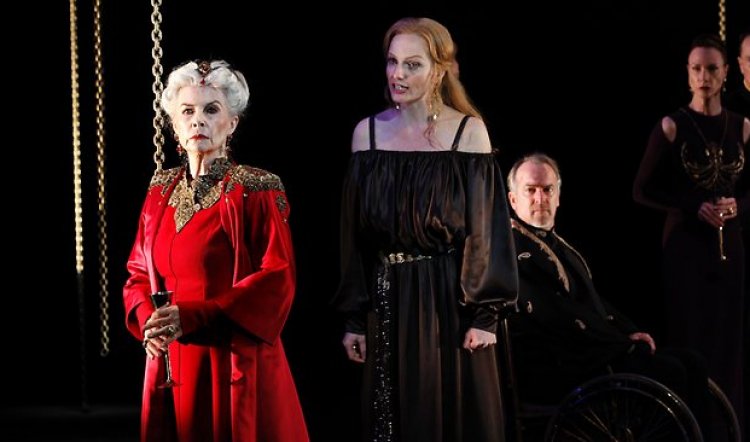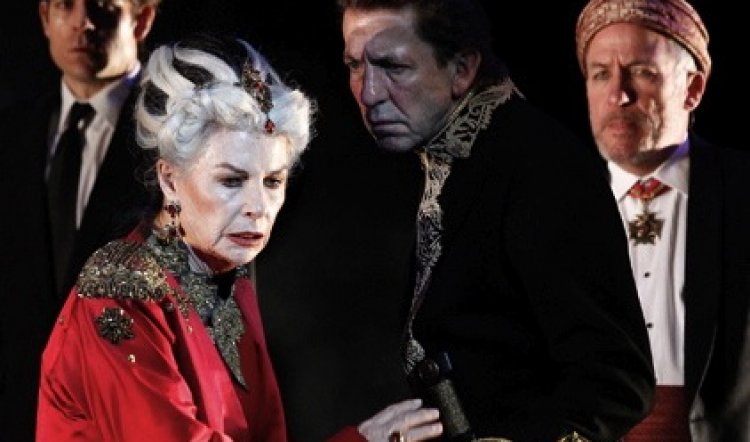
QUEEN LEAR
QUEEN LEAR, Melbourne Theatre Company in the Sumner Theatre, July 12-August 18, 2012. Photos by Jeff Busby: Robyn Nevin, Alexandra Schepisi, Belinda McClory and Nicholas Hammond.
When it was announced in 2011 that Robyn Nevin would take the title role in a gender reassigned production of King Lear for the Melbourne Theatre Company, the ripples of anticipation reached Sydney in about two minutes. My decision was made, on the spot, that a trip to Melbourne to see it was a must. The MTC media person had no interest in a Sydney reviewer attending, so opening night wasn't possible; the earliest decent seats available online: Tuesday, 25 July.
And the flying fickle finger of fate being what it is, that meant the luckless actors in what was always going to be a controversial staging (QUEEN Lear?? What???) had already been engulfed in a fire storm of negative reviews from Melbourne's mainstream critics. There were others - equivocal or positive - but according to Twitter comments and the inevitable gossip, the initial reviews were killers - causing the word of mouth to become toxic. And that was obvious from casual conversations in just 36 hours in Melbourne ("oh no, I'm not going to that; it's had terrible reviews").
The thing is, however, I haven't yet read the reviews and have stayed as far away from the gossip as is humanly possible in a gossipy milieu. I really wanted to see Queen Lear with the same sense of excitement and anticipation I'd felt when it was first announced. So, for a start, this is a play about a woman in a man's world; it's titled Queen Lear, not King Lear. This strongly signals that it's definitely not the latter and going in with preconceptions or memories of past versions of that play is not a good idea. (Never is, of course, but in this instance it needs to be reinforced.)
The play opens in spectacular style with the scarlet-clad monarch (Robyn Nevin) making a final check in a mirror before marching to an encounter with her court and family. She moves with febrile, desperate energy and presence. Think Elizabeth I in her last decades - one stumble or show of weakness or uncertainty and the circling pretenders will pounce. Nevin is instantly electrifying as she strides along a path of stark white light that surrounds a rectangular black void of ominous symbolism. Her shoulders and breast glitter with gold epaulettes and embroidery. The image is regal, militaristic and compelling; the epitome of powerful woman - feared, desired and unattainable - in whom and through whom love and hate are channeled with fatal inevitability.
As she greets her daughters and court it becomes apparent that there is no reason whatsoever why, in this context, the monarch should not be a queen. Why Shakespeare might not have had Elizabeth in the back of his mind - the overwhelming and terrifying dictator who put power and her throne above all else; whose humanity was gradually leached away by her determination to stay on top. Whose sanity one would have to question as she spin doctored her image as Gloriana while England fell ever deeper into debt and spy-ridden misery. And it's worth remembering that in Shakespeare's maturity Elizabeth was a raddled, miserable despot - not Cate Blanchett, nor Glenda Jackson, nor Bette Davis.
So, nobody actually knows on whom Shakespeare based Lear; there is much surmise and lots of "probables" as to which Celtic king or legend he may have referenced, but the truth is, no one knows and it really doesn't matter. Throughout his career the playwright sampled and magpied from endless sources, obscure and otherwise; and in the end he made them his own. Might he not, therefore, have been thinking of the recently-dead queen when he conjured up the central character in this profound exploration of power and its ability to corrupt and destroy? For argument's sake, let's say he was. Rather than a wily old patriarch, therefore, we are presented with a matriarch whose weariness is all the more credible as the emotional and existential exhaustion of the female in a patriarchy, albeit its ruler.
Whatever supposition one might dream up, it remains true that Shakespeare himself wouldn't have been particularly fussed by a director's decision to make such a change. He wanted his plays to be successful: to be staged and to have audiences clamouring for more. If he'd been as precious about the script - as are some of the more ferocious text guardians - he would surely not have written an alternative happy ending to Lear as he did when punters complained that it was too tragic! This production's director and dramaturg, Rachel McDonald, is in good company therefore in her artistic choices. And it's hardly a unique sacrilege. Imagine the response of today's diehard purists if she'd had Lear decide to take back the throne and continue a glorious reign (Shakespeare); or insert a happy marriage between Edgar and Cordelia (as per poet laureate Nahum Tate in 1681). Tate also did away with the Fool, while McDonald splits the character between somewhat ghostly visions of the three sisters; it's a better decision in this instance as it throws up all kinds of shivery apparitions about mothers and daughters and their often tortured relationships.
The queen's dangling of the territorial inheritance carrots in front of her daughters becomes a classic ploy of the controlling mother against the girls' seething desire for the impossible - autonomy. When Goneril (Genevieve Picot) and Regan (Belinda McClory) buck their mother's authority and then so quickly fall in line - with their fulsome declarations of love - it is both predictable and unsatisfying and surely feeds Lear's wish to be done with it all. Nevertheless, for the old queen, accustomed to sycophancy and the instinctive kowtow, Cordelia's inability to go along with what's required is an almighty affront. The psychic unravelling precipitated by it is partly the despair of the matriarch in terminal decline and the rage of the flouted ruler.

Throughout the play, the contradictory push and pull of emotion, positive and negative, between the queen and her daughters becomes increasingly painful and realistic. Lear's frustration grows as she slides into a physical and emotional neediness that her position and history cannot satisfy; not for nothing does she occupy a solitary throne. Nevin is dynamic and heart-rending in portraying this irreconcilably complex woman and the rest of the company ebbs and flows, more or less successfully around her.
As the elder sisters, Picot and McClory crackle with ambition and animosity. They are scorpion-like in their willingness and ability to sting and, of course, like real scorpions they end up stinging themselves most horribly. As the honest young Cordelia, Alexandra Schepisi - so brilliantly effective in the recent movie The Eye of the Storm - seems unsure and out of her depth, although there are frequent flashes of warmth and fire that suggest she's steadily growing into the stage role. As Kent, the queen's most loyal courtier, Robert Menzies is riveting in his passionate devotion to his duty to his sovereign - even when his heart and conscience are ripped asunder. He is a thrilling presence.
Nicholas Hammond is a dandified Cornwall, his carefree old Etonian demeanour suggesting those depths of imaginative barbarism most enjoyed by the aristocracy. As the ill-fated Gloucester Richard Piper generates some of the production's most touching and terrible moments; after the gouging of his eyes his travails as a blinded and broken man are pitiful to watch. The contrast is marked between these men and Albany (Greg Stone) who, confined to a wheelchair, is a waspish observer whose antennae are constantly on the alert for impediments - real and political - while he strives to keep pace with Goneril while not getting in the way of his wife's angry ambition.
David Paterson (Edmund) and Rohan Nicholl (Edgar) as Gloucester's bastard and son are the antithesis of each other - one as cool and distant as the other is intensely physical. Like Cordelia, they too have their sparkling moments but their performances suggest the absence of a director more sympathetic to and more experienced with actors. A theory, but McDonald is a newcomer to mainstage and large scale productions and the occasional disjointed exchanges and marooned actors reek of a lack of empathy with their plight and needs.
On the creative side, Composer Iain Grandage makes vivid washes of sound and atmosphere that enliven and enlighten the action. Tracy Grant Lord has concocted a rather odd set: gold chains hang from on high, occasionally a prop is attached to one or other; occasionally a chain continues to fall after reaching the floor curling up on itself like some sort of worm cast. An over-large pastoral landscape painting is lowered a couple of times - the kingdom, lest Lear needs reminding, perhaps. Most encounters and major face-offs take place on and around a quasi-Victorian Gothic plinth thing that looks rather like a municipal fountain and horse trough. And the storm scene is made almost cataclysmic by Niklas Pajanti's lighting design that makes the roiling clouds, aka glittering swirls of razor wire, quite horrifying to observe. Mostly, however, the stage is unencumbered - aside from the chains - and the actors can get on with it in costumes that hint at somewhere non-specific that might be Ruritania.
Nonetheless, Queen Lear is a thought-provoking and rewarding experience. It will not satisfy purists. It will not satisfy lovers of King Lear. But it is extremely entertaining, the actors are heroic, led from the front by Robyn Nevin, and the basic idea is fascinating and in the main it works. Id est sicut est - It is what it is.



